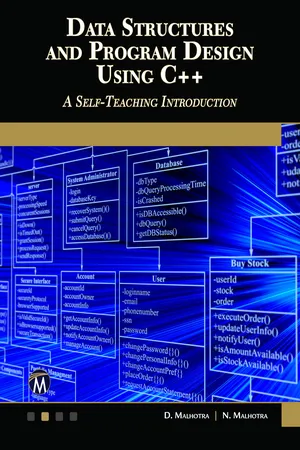Computer Science
Java Arrays
Java arrays are a collection of variables of the same data type that are stored in contiguous memory locations. They are used to store and manipulate large amounts of data efficiently. Arrays can be one-dimensional or multi-dimensional and are an important concept in Java programming.
Written by Perlego with AI-assistance
Related key terms
8 Key excerpts on "Java Arrays"
- eBook - ePub
Data Structures and Program Design Using Java
A Self-Teaching Introduction
- D. Malhotra, N. Malhotra(Authors)
- 2020(Publication Date)
- Mercury Learning and Information(Publisher)
3ARRAYS
3.1 Introduction
In the previous chapter we studied the basics of programming in data structures and Java in which we aimed to design good programs, where a good program refers to a program which runs correctly and efficiently by occupying less space in the memory, and also takes less time to run and execute. Undoubtedly, a program is said to be efficient when it executes with less memory space and also in minimal time. In this chapter, we will learn about the concept of arrays. An array is a user-defined data type that stores related information together. Arrays are discussed in detail in the following sections.3.2 Definition of an Array
An array is a collection of homogeneous (similar) types of data elements in contiguous memory. An array is a linear data structure, because all elements of the array are stored in linear order. Let us take an example in which we have ten students in a class, and we have been asked to store the marks of all ten students; then we need a data structure known as an array.Figure 3.1. Representation of an array of ten elements.In the previous example, the data elements are stored in the successive memory locations and are identified by an index number (also known as the subscript), that is, Ai or A[i]. A subscript is an ordinal number which is used to identify an element of the array. The elements of an array have the same data type, and each element in an array can be accessed using the same name.Frequently Asked Questions
1. What is an array? How can we identify an element in the array?Ans: An array is a collection of homogeneous (similar) types of data elements in contiguous memory. An element in an array can be identified by its index number, which is also known as a subscript.3.3 Array Declaration
We know that all variables must be declared before they are used in the program. Therefore, the same concept also holds with array variables. An array must be declared before it is used. During the declaration of an array, the size of the array has to be specified. Declaring an array involves the following specifications: - eBook - ePub
JAVA Programming Simplified
From Novice to Professional - Start at the Beginning and Learn the World of Java
- Dr. Muneer Ahmad Dar(Author)
- 2020(Publication Date)
- BPB Publications(Publisher)
HAPTER 5Understanding Arrays, Strings, and Wrapper Classes
Introduction
An array is a collection of similar-typed variables with the intention of referring them by a general name which is common for all the variables. Arrays of every type can be formed and may possibly have one or more dimensions. A precise component in an array is accessed by its index. Arrays put forward a suitable way of grouping associated information. Suppose we are asked to write a program in which we have to create 100 student roll numbers. One option is to create 100 int variables and that is not the recommended approach as it will make a very complicated program. In order to write the concise and efficient programs, the alternative approach is to create an array which is a group of contiguous or related data items that share a common name. For instance we can define an int array roll to represent a set of roll numbers of 100 different students. If we want to access any of the roll number, we have to use the index or subscript in brackets after the array name as:roll[60]; // represents the roll number of 60th studentWith the help of a single looping structure we can access all the elements of an array by changing the index value within the loop. In this chapter we will discuss the one dimensional and two dimensional arrays in detail and we will also focus on strings and vectors in detail.Structure
- Introduction
- Implementation of 1-D arrays
- Implementation of 2-D arrays
- String handling in Java
- StringBuffer class
- Type wrappers in Java
- Assignments
Objective
This chapter explains Arrays in detail. The String handling and Wrapper classes are also explained in this chapter. - eBook - ePub
- D. Malhotra, N. Malhotra(Authors)
- 2019(Publication Date)
- Mercury Learning and Information(Publisher)
3ARRAYS
In This Chapter• Introduction• Definition of an array• Array declaration• Array initialization• Calculating the address of array elements• Analyzing an algorithm• Abstract data types• Declaration of two-dimensional arrays• Operations on 2-D arrays• Multidimensional arrays/ N-dimensional arrayys• Calculating the address of 3-D arrays• Arrays and pointers• Array of pointers• Arrays and their applications• Sparse matrices• Types of sparse matrices• Representation of sparse matrices• Summary• Exercises3.1Introduction
We have already studied the basics of programming in data structures and C++ in the previous chapter in which we aimed to design good programs, where a good program refers to a program which runs correctly and efficiently by occupying less space in the memory, and also takes less time to run and execute. Undoubtedly, a program is said to be efficient when it executes with less memory space and also in minimal time. In this chapter, we will learn about the concept of arrays. An array is a user-defined data type that stores related information together. Arrays are discussed in detail in the following sections.3.2Definition of an Array
An array is a collection of homogeneous (similar) types of data elements in contiguous memory . An array is a linear data structure because all elements of the array are stored in linear order. Let us take an example in which we have ten students in a class, and we have been asked to store the marks of all ten students; then we need a data structure known as an array.FIGURE 3.1 .Representation of an array of 10 elements.In the previous example, the data elements are stored in the successive memory locations and are identified by an index number (also known as the subscript), that is, Ai or A[i]. A subscript is an ordinal number which is used to identify an element of the array - eBook - ePub
Programming Fundamentals Using JAVA
A Game Application Approach
- William McAllister, S. Jane Fritz(Authors)
- 2021(Publication Date)
- Mercury Learning and Information(Publisher)
In addition to modifying text files and data files, these file operations will also enable us to record players’ scores and update the high scores of a game.6.12 CHAPTER SUMMARYThe concept of an array presented in this chapter provides us with a powerful tool for storing, retrieving, and processing data, especially large data sets. Unlike primitive variables, which contain only a single value, an array contains multiple data elements that are all of the same type. When an array is created, its data items are all initialized to their default values. The index of an array always begins at zero and extends to n-1, where n is the number of elements in the array (the size of the array). To distinguish one element from another, we use an index after the array name, as in an element’s name, grade[4] , which is the name of the fifth element of the array.In Java, all arrays are stored inside an object. This object is declared using a syntax similar to that used to declare non-array objects. A set of brackets is added to the declaration after the object’s type, and a second set of brackets containing the size of the array is written after the keyword new . Every array has a public data member named length, which stores the size of a one-dimensional array or the number rows in a two-dimensional array. Two-dimensional arrays also contain an array of public data members named length whose elements store the number of elements in each row of the array.Loops are often used to efficiently input, output, and process the data in an array using the loop variable as an index into the array. Array elements can be used in any Java statement where a variable can be used; they can receive input and be output, used in mathematical expressions, assigned values, passed as an argument into a method, and returned from a method. In addition, like any object, the location of an array object can be passed to a method and returned from it. The concept of parallel arrays is implemented using either multiple one-dimensional arrays or using multidimensional arrays. In either case, we can use this concept to organize related information such as student ID numbers and GPAs and quickly and efficiently access it. - eBook - ePub
Composite Data Structures and Modularization
Volume 2: Composite Data Structures and Modularization
- Xingni Zhou, Qiguang Miao, Lei Feng(Authors)
- 2020(Publication Date)
- De Gruyter(Publisher)
We can use a for loop to process grades for a single student and use another one to calculate average grades for all of them. The algorithm and code implementation will be given in the section of two-dimensional arrays.1.1.2 Representation of data of the same type
The discussion earlier showed that a new mechanism is necessary to handle data of the same type. With respect to data representation and processing, arrays are a data structure that regularly expresses data so that they are processed regularly.Since arrays are collections of variables whose names have a pattern, they are supposed to have features of variables. Figure 1.6 compares arrays with plain variables.Figure 1.6: Comparison of a group of variables with a single variable.During the definition of a plain variable, the system allocates memory according to its type specified by programmers. The definition of an array consists of type, name and, in particular, the number of variables in the array.There are multiple variable values in an array, so they should be stored in multiple storage units, whose sizes depend on types of the variables. The size of a storage unit is measured in bytes and can be computed using the sizeof operator.Besides, a referencing method of the address of a storage unit is necessary so that programmers can inspect the unit. We can infer from the examples earlier that the referencing method of variable values in an array is to use the array name with an index. Moreover, we should be able to initialize an array since we can do the same with plain variables. Hence, a corresponding syntax is necessary.1.2 Storage of arrays
There are four issues related to array storage, namely definition, initialization, memory allocation, and memory inspection.1.2.1 Definition of arrays
1.2.1.1 Definition of arrays
An array is a collection of data of the same type. Figure 1.7 - eBook - ePub
C Programming
Learn to Code
- Sisir Kumar Jena(Author)
- 2021(Publication Date)
- Chapman and Hall/CRC(Publisher)
This chapter is dedicated to a discussion of arrays. After completion of this chapter, readers will have learnt the following:- How to define an array and its type;
- How to write code to declare different types of arrays, like 1D arrays and 2D arrays, and use them for solving problems;
- Declaration, processing, and manipulation of strings (also known as character arrays).
10.2 Need for Arrays
A variable can hold one value at a time. There are situations in which we want to store more than one value at a time. Suppose we want to store the age of 100 persons and arrange them in a sorted manner. This type of problem can be solved by taking 100 variables, where each variable contains the age of a single person. But this is an inconvenient way to solve this problem. A more elegant way is to use an array. So, before we solve different types of problems, we should know the basic concept of an array.10.3 Types of Arrays
According to the definition, an array is a collection of compartments. Further, we can say the elements of an array can be stored in a row of compartments, or can be stored in the form of a table. Depending upon the representation style and the type of data it contains, the array can be classified as shown in Figure 10.2 .A character array (string) is of the type 1D array (i.e., the array which contains only character data).Figure 10.2 Classification of arrays.10.4 1D Arrays
A 1D array is a collection of items having common data types stored in a contiguous memory location, identified by a single name with its index number. More generally, suppose we have stored five different integers in a continuous memory location with a common name. We can access each integer with the help of the name of the array and index number – then the whole scenario is called an integer array. - eBook - ePub
C Programming
A Self-Teaching Introduction
- Rajiv Chopra(Author)
- 2017(Publication Date)
- Mercury Learning and Information(Publisher)
CHAPTER 3ARRAYS AND POINTERS
3.0 INTRODUCTION
S ay we wish to store the marks of 3000 students at our college; if I use variables, more than 3000 variables are required. This is very tedious and cumbersome. So to solve this type of problem, we use an array that has a common name with a subscript representing the index of each element. Thus, an array is an ordered sequence of finite data items of the same data type that share a common name. The common name is the array name and each individual data item is known as an element of the array.An array is defined as a set of a similar type of elements that are stored contiguously in memory. This means that the elements of an array are stored in the subsequent memory locations starting from the first memory location of the block of memory created for the array.Each element of an array can be referred to by an array name and a subscript or an index. Please note that all elements of an array should be of similar type. Arrays can have one of more dimensions—one-dimensional (1D), two-dimensional (2D), or multidimensional. A one-dimensional array uses a single index and atwo-dimensional array uses two indexes, and so on. A 1D array can be used to represent a list of data items and is also known as a vector or a list. Similarly, a 2D array can be used to represent a table of data items consisting of rows and columns. It is also known as a matrix. A 3D array can be used to represent a collection of tables. The concept can go beyond three dimensions also.The dimension of the array is known as its rank. For instance, a 1D array has rank 1, a 2D array has a rank of 2, and so on. The number of subscripts is determined by the rank of an array. Thesize or length of each dimension is represented by an integral value greater than or equal to 0. The total number of elements in an array is the product of the sizes of each dimension in an array. If any one or more of the dimensions of an array have size 0, the array is known as an empty array.An array may be regular or ragged. A ragged/jagged array - eBook - ePub
C
From Theory to Practice, Second Edition
- George S. Tselikis, Nikolaos D. Tselikas(Authors)
- 2017(Publication Date)
- CRC Press(Publisher)
7 ArraysThe variables we’ve used so far can store a single value. In this chapter, we’ll talk about a new type of variable capable of storing a number of values. This type is called array. An array may be multidimensional. We’ll focus on the simplest and most usual kinds: the one-dimensional and two-dimensional arrays. To introduce you to arrays, we’ll show you how to use arrays of integers and floating-point numbers. We’ll discuss other types of arrays, as well as their close relationship to pointers in later chapters. In Chapter 12 , we’ll describe some popular algorithms for searching a value in an array and sorting its elements.
An array is a data structure that contains a number of values, or else elements, of the same type. Each element can be accessed by its position within the array.One-Dimensional Arrays
To declare a one-dimensional array, we must specify its name, the number of its elements, and its data type, like this:Declaring Arraysdata_type array_name[number_of_elements];The number_of_elements , or else the length of the array, is specified by an integer constant expression greater than 0 enclosed in brackets. A popular error is to use a variable whose value is set during the program execution. No, it is not allowed. All the elements are of the same type; it may be of any type (e.g.,int,float,char, …). For example, the statement:int arr[1000];declares the array arr with 1000 elements of type int . To realize the importance of arrays, imagine that if C didn’t support this type of aggregate variable, we’d have to declare 1000 different integer variables.If the length of the array is used several times in the program, a good practice is to use a macro instead. If you ever need to change it, you just change the macro. For example:The length of an array cannot change during the program execution. It remains fixed.#define SIZE 150 float
Learn about this page
Index pages curate the most relevant extracts from our library of academic textbooks. They’ve been created using an in-house natural language model (NLM), each adding context and meaning to key research topics.







